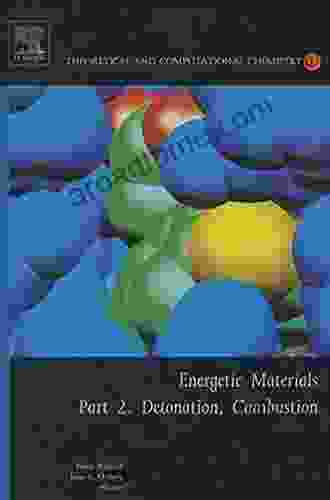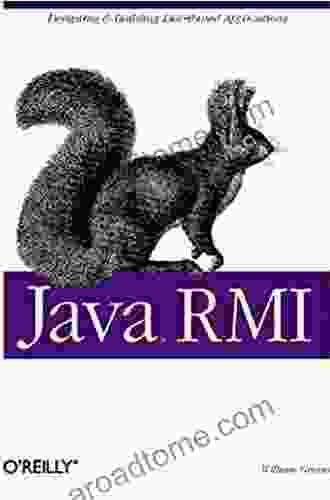Mastering the Art of Distributed Applications with Java RMI

In today's interconnected world, the ability to seamlessly connect and exchange data across different devices, applications, and systems is paramount. Java RMI (Remote Method Invocation) provides an invaluable tool for developers to create distributed applications that can span multiple physical or virtual machines. This comprehensive guide will delve into the intricacies of Java RMI, empowering you to design and build highly effective distributed applications.
Understanding Java RMI
Java RMI is a Java-based technology that enables remote objects to communicate with each other across a network. It allows an object running on one machine to invoke methods on an object running on another, as if they were in the same process. This remote communication is achieved through the use of proxies and stubs, which act as intermediaries between the distributed objects.
5 out of 5
| Language | : | English |
| File size | : | 2669 KB |
| Text-to-Speech | : | Enabled |
| Screen Reader | : | Supported |
| Enhanced typesetting | : | Enabled |
| Print length | : | 929 pages |
Key Concepts:
* Remote Objects: Objects that can be invoked remotely from other processes or machines. * Proxies: Objects that represent remote objects on the client side, handling the necessary communication and method invocations. * Stubs: Objects that reside on the server side, receiving method invocations from remote clients and forwarding them to the actual implementation classes.
Designing Distributed Applications with Java RMI
Designing effective distributed applications requires a thoughtful understanding of the key principles and patterns. Java RMI provides several design considerations:
* Interface Definition: Define a common interface that clients and servers will use to communicate. This interface serves as the contract between the two sides. * Remote Interfaces: Mark the interface as remote to specify that it can be accessed remotely using RMI. * Implementation Classes: Implement the remote interface to provide the actual functionality of the distributed application. * Server-Side Setup: Configure the server to export the remote object, making it available for remote invocation. * Client-Side Setup: Create a proxy object on the client side, which will facilitate remote method invocations on the server-side object.
Building Robust Java RMI Applications
Building reliable and performant distributed applications requires careful attention to various factors. Java RMI offers several features to enhance the robustness of your applications:
* Exception Handling: Handle exceptions that may arise during remote method invocations gracefully, providing informative error messages to aid in debugging. * Serialization: Implement serialization mechanisms to enable the transfer of data between client and server, facilitating the exchange of complex objects. * Security: Utilize security measures such as authentication and authorization to protect your applications from unauthorized access and attacks.
Performance Optimization in Java RMI
Optimizing the performance of Java RMI applications is essential to ensure efficiency and scalability. Consider the following techniques:
* Minimize Network Traffic: Optimize data transfer by using lightweight data structures and reducing the number of remote invocations. * Caching: Implement caching mechanisms to store frequently accessed data, reducing the need for repeated remote invocations. * Load Balancing: Distribute the load across multiple servers to handle high volumes of remote requests effectively.
Java RMI provides a powerful platform for developing distributed applications that seamlessly connect and exchange data across multiple devices and systems. By embracing the principles and best practices outlined in this guide, you can design, build, and optimize robust, scalable, and efficient Java RMI applications. Enhance your distributed programming skills, unlock the potential of Java RMI, and confidently develop applications that meet the demands of today's interconnected world.
5 out of 5
| Language | : | English |
| File size | : | 2669 KB |
| Text-to-Speech | : | Enabled |
| Screen Reader | : | Supported |
| Enhanced typesetting | : | Enabled |
| Print length | : | 929 pages |
Do you want to contribute by writing guest posts on this blog?
Please contact us and send us a resume of previous articles that you have written.
 Book
Book Novel
Novel Page
Page Chapter
Chapter Text
Text Story
Story Genre
Genre Reader
Reader Library
Library Paperback
Paperback E-book
E-book Magazine
Magazine Newspaper
Newspaper Paragraph
Paragraph Sentence
Sentence Bookmark
Bookmark Shelf
Shelf Glossary
Glossary Bibliography
Bibliography Foreword
Foreword Preface
Preface Synopsis
Synopsis Annotation
Annotation Footnote
Footnote Manuscript
Manuscript Scroll
Scroll Codex
Codex Tome
Tome Bestseller
Bestseller Classics
Classics Library card
Library card Narrative
Narrative Biography
Biography Autobiography
Autobiography Memoir
Memoir Reference
Reference Encyclopedia
Encyclopedia Vidyadhar G Kulkarni
Vidyadhar G Kulkarni Srinivas Bharadwaj
Srinivas Bharadwaj Susan Albers
Susan Albers Brian L Weiss
Brian L Weiss Sylvaine Jaoui
Sylvaine Jaoui Suparna Chakrabarti
Suparna Chakrabarti Vyasa
Vyasa Phil Attard
Phil Attard Will Schmid
Will Schmid Stefan Timmermans
Stefan Timmermans Mobo Reader
Mobo Reader Uri Geller
Uri Geller Tim Cliss
Tim Cliss Frederic De Lavenne De Choulot
Frederic De Lavenne De Choulot Walter Sinnott Armstrong
Walter Sinnott Armstrong Stephen Lucas
Stephen Lucas Victor Leung
Victor Leung Juana Medina
Juana Medina Suzanne Supplee
Suzanne Supplee Vince Buffalo
Vince Buffalo
Light bulbAdvertise smarter! Our strategic ad space ensures maximum exposure. Reserve your spot today!

 Tom HayesMy Love For You All Year Round: A Heartwarming Tale of Family and the Turning...
Tom HayesMy Love For You All Year Round: A Heartwarming Tale of Family and the Turning...
 Chadwick PowellBarack Obama vs. The Black Hebrew Israelites: A Clash of Faiths and Politics
Chadwick PowellBarack Obama vs. The Black Hebrew Israelites: A Clash of Faiths and Politics Juan ButlerFollow ·6.2k
Juan ButlerFollow ·6.2k Sam CarterFollow ·11.2k
Sam CarterFollow ·11.2k Jarrett BlairFollow ·8k
Jarrett BlairFollow ·8k Felix HayesFollow ·10.9k
Felix HayesFollow ·10.9k Houston PowellFollow ·10.2k
Houston PowellFollow ·10.2k Bruce SnyderFollow ·4.8k
Bruce SnyderFollow ·4.8k Arthur MasonFollow ·11.7k
Arthur MasonFollow ·11.7k Kurt VonnegutFollow ·4.8k
Kurt VonnegutFollow ·4.8k

 Timothy Ward
Timothy WardSteamy Reverse Harem with MFM Threesome: Our Fae Queen
By [Author...

 Cody Blair
Cody BlairThe Ultimate Guide to Energetic Materials: Detonation and...
Energetic materials are a fascinating and...

 Kenzaburō Ōe
Kenzaburō ŌeProstitution, Modernity, and the Making of the Cuban...
By Emily A....

 Kirk Hayes
Kirk HayesUnveil the Enchanting World of The Rape of the Lock by...
Alexander Pope's epic...

 Ivan Turgenev
Ivan TurgenevTantric Quest: An Encounter With Absolute Love
Embark on a Tantric Quest to...

 Gary Reed
Gary ReedThe Darwin Awards: Evolution in Action
The Darwin Awards are a...
5 out of 5
| Language | : | English |
| File size | : | 2669 KB |
| Text-to-Speech | : | Enabled |
| Screen Reader | : | Supported |
| Enhanced typesetting | : | Enabled |
| Print length | : | 929 pages |








